It has been almost two weeks since I (along with 200,000 others) made history watching the queen Taylor Swift play Murrayfield.
It’s funny because, while I adore her music, I am not sure I can assume the title of Swiftie.
It was only during lockdown that I started to listen to her music, and I can honestly say the albums she released during the pandemic saw me through a pretty difficult time.
But, until then, she hadn’t crossed my radar. I guess you could say (and she does) she had a bit of a reputation.
In fact, her reputation was so bad, she wrote an album about it.
For those unfamiliar with the story, the huge success of Taylor Swift’s album 1989 propelled the young singer into the public eye in a momentous way. Coming under scrutiny by the media, her private life and public image were torn to shreds, forcing her to retreat for around three years before Reputation was released in 2017.
Standing there amongst the buzz of the first night in Edinburgh, it seemed impossible to believe she struggled through something like that. The transformation is truly quite incredible.
To go from a young woman who felt the need to hide from the world to arguably the biggest pop star of her time is quite some feat. It got me thinking about how you can always turn things around, even when it seems impossible.

A few weeks ago, I noticed a post on LinkedIn discussing the damage Aberdeen’s image was causing the city’s regeneration efforts. Important conversations around the marketing and selling of the M&S store on Union Street were stalling because “national retailers consider Dundee a more attractive option”.
And the reason behind this, it would appear, was because of the reputation we had given ourselves.
Aberdeen has seen a significant decline in the last 10 years, since the start of the 2014-15 oil and gas downturn, there is no denying that. Meanwhile, the rise of online shopping and the impacts of both Brexit and Covid have taken their toll on the city centre, in particular.
But good things are happening.
I am aware people don’t always consider change to be good. But for things to improve, change needs to happen.
A multimillion-pound masterplan exists to upgrade our beachfront, develop a new market, upgrade Union Street and regenerate the Queen Street area. This, alongside the reopening of Union Terrace Gardens, signals significant investment in the regeneration of the city.
Yet, to an outsider looking in – why is it all they ever hear is negative diatribes?
Changing the city’s mindset
In order for things to improve in Aberdeen, there needs to be an assertive, collective effort to sing its praises.
I am not for one second suggesting we shouldn’t call out issues where they arise – I am the first to do so. Especially if, like the bus gates, they appear to be hampering the regeneration efforts.
How many people actively engage with the city council when consultations take place? In the grand scheme of things, not many
But it’s not good enough to moan about something repeatedly once a decision has been made if you’ve not made any attempt to try to influence it.
How many people actively engage with the city council when consultations take place? In the grand scheme of things, not many.
We as a city need to change our mindset from negative to positive. We also need to be more willing to speak up when local opinions matter.
From Tay Tay to the River Tay
A few years ago, I was in Dundee for an event. I needed to get a taxi from the hotel I was staying at into the centre of town, and got chatting with the driver.
I hadn’t been in the city much in the months before that, and started asking some questions about the redevelopment. The driver then stopped the meter and proceeded to drive me around the waterfront and city centre to show it off.
In that moment, I could tell just how proud he was of his home. This outlook is what we need to instil in Aberdonians.
Instead of thinking about our city as one in decline, why not talk about it as up and coming? After all, if you say something often enough, you’ll start to believe it.
Just like Tay Tay, Dundee has also seen its reputation flip in recent years. Once known as a rather rough city with drug-related problems, it’s now considered a buzzing hub of independent businesses and culture. Just look what it has achieved with the V&A and newly approved Eden Project.
If we can turn around Aberdeen’s reputation in a similar way, the city might benefit from inward investment.
It’s time for locals to work on that change. We have all the makings to write a pretty explosive comeback album.
Rebecca Buchan is deputy head of news and sport for The Press and Journal and Evening Express



Conversation